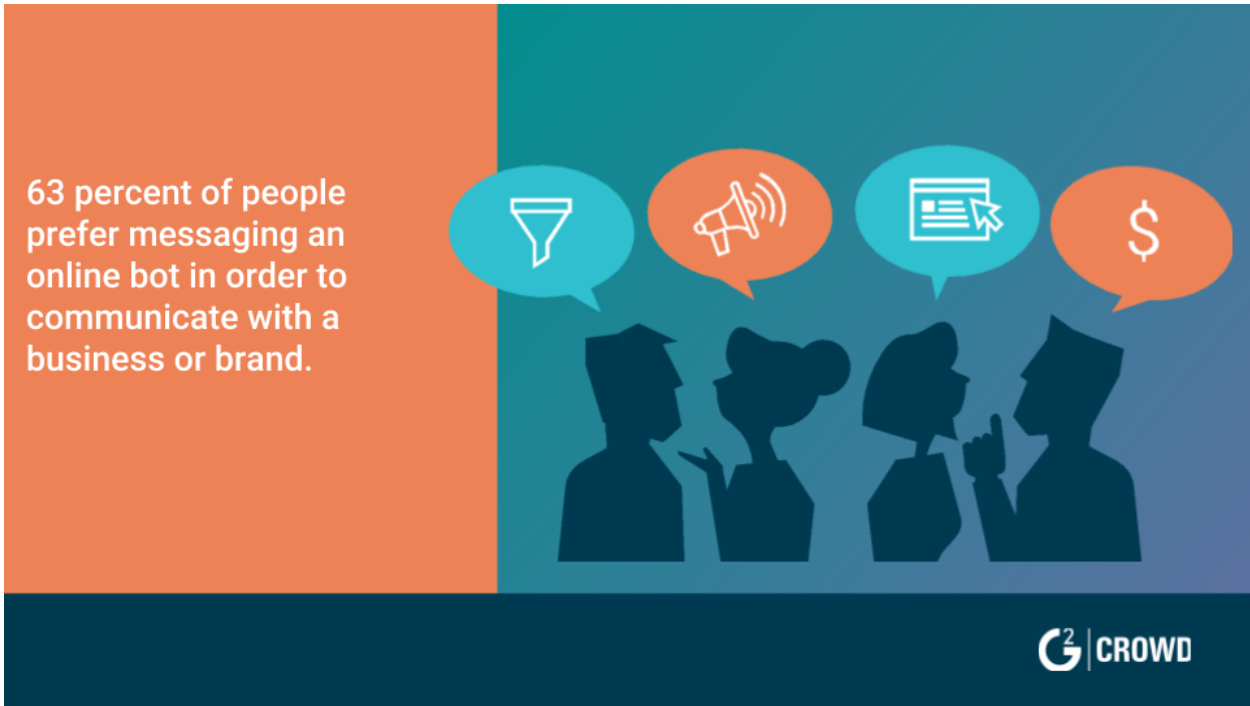Businesses are using artificial intelligence to automate tasks, improve sales and marketing analysis, and even solve complex health problems.
copyright by learn.g2crowd.com
 The use cases for artificial intelligence are boundless.
The use cases for artificial intelligence are boundless.
Businesses are using artificial intelligence to automate tasks, improve sales and marketing analysis, and even solve complex health problems.
While artificial intelligence platforms are a pioneering technology, most people cannot identify the different types of artificial intelligence and the variety of ways they can be deployed to improve business processes. Artificial intelligence statistics
These statistics and background information provide insight into the most popular types of artificial intelligence and how they have impacted how businesses use (and will continue to use) technology in 2019.
Chatbot statistics
A chatbot is an artificially intelligent computer program that is designed to communicate with a human through auditory or textual methods. Chatbots are often used as customer service agents on a website’s home page or automated responses on a business’ phone line. Chatbots have machine learning capabilities which allows them to build off previous conversational data from a customer and use that to personalize future conversations.
Businesses can leverage the power of chatbots to initialize and engage in a relationship with a customer. Since plenty of users can be visiting website at the same time, it’s helpful to have a machine that can answer hundreds of users at once rather than have ten or more customer service representatives juggle questions and requests from visitors. Chatbots are faster, less invasive and cut costs.
- 44 percent of executives believe artificial intelligence’s most important benefit is providing data that can be used to make decisions. (Chatbots Magazine)
- The top benefits of chatbots are 24-hour service (64 percent), instant responses to inquiries (55 percent) and answers to simple questions (55 percent). (The 2018 State of Chatbots Report)
- 63 percent of the people prefer messaging an online bot to communicate with a business or brand. (Mindshare)
Virtual assistant statistics
A digital virtual assistant is a useful type of artificial intelligence that resides within a phone, tablet or computer and is designed to help users complete online tasks. This can include managing your daily schedule, answering simple questions and even turning on the lights in your home.
Thank you for reading this post, don't forget to subscribe to our AI NAVIGATOR!
On the business side of things, Google is working on ways that will enable voice technology to automate tasks such as expense tracking, e-commerce, fleet management and email marketing. Since digital assistants are so dynamic in their use cases, expect them to grow in popularity over the next few years. Popular virtual assistants include Amazon’s Alexa, Apple’s Siri and Google Assistant.
- 72 percent of business executives believe digital assistants help make their lives easier. (PwC)
- 55 percent of people use digital voice assistants because it allows them to keep their hands free. (GO-Gulf)
- The growth of virtual assistants is expected to reach $15.79 billion by 2021. (ValueWalk)
- In 2018, the worth of the virtual digital assistant market was $5.21 billion worldwide. (GO-Gulf)
[…]
read more – copyright by learn.g2crowd.com


Businesses are using artificial intelligence to automate tasks, improve sales and marketing analysis, and even solve complex health problems.
copyright by learn.g2crowd.com
Businesses are using artificial intelligence to automate tasks, improve sales and marketing analysis, and even solve complex health problems.
While artificial intelligence platforms are a pioneering technology, most people cannot identify the different types of artificial intelligence and the variety of ways they can be deployed to improve business processes. Artificial intelligence statistics
These statistics and background information provide insight into the most popular types of artificial intelligence and how they have impacted how businesses use (and will continue to use) technology in 2019.
Chatbot statistics
A chatbot is an artificially intelligent computer program that is designed to communicate with a human through auditory or textual methods. Chatbots are often used as customer service agents on a website’s home page or automated responses on a business’ phone line. Chatbots have machine learning capabilities which allows them to build off previous conversational data from a customer and use that to personalize future conversations.
Businesses can leverage the power of chatbots to initialize and engage in a relationship with a customer. Since plenty of users can be visiting website at the same time, it’s helpful to have a machine that can answer hundreds of users at once rather than have ten or more customer service representatives juggle questions and requests from visitors. Chatbots are faster, less invasive and cut costs.
Virtual assistant statistics
A digital virtual assistant is a useful type of artificial intelligence that resides within a phone, tablet or computer and is designed to help users complete online tasks. This can include managing your daily schedule, answering simple questions and even turning on the lights in your home.
Thank you for reading this post, don't forget to subscribe to our AI NAVIGATOR!
On the business side of things, Google is working on ways that will enable voice technology to automate tasks such as expense tracking, e-commerce, fleet management and email marketing. Since digital assistants are so dynamic in their use cases, expect them to grow in popularity over the next few years. Popular virtual assistants include Amazon’s Alexa, Apple’s Siri and Google Assistant.
[…]
read more – copyright by learn.g2crowd.com
Share this: